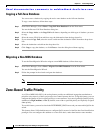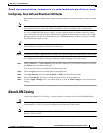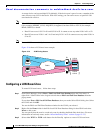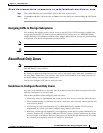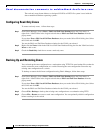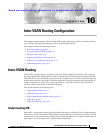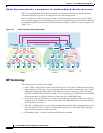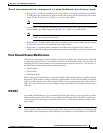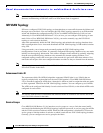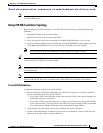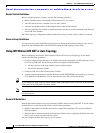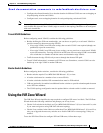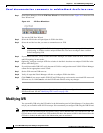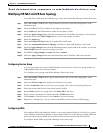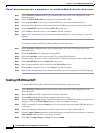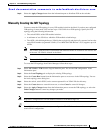
Send documentation comments to mdsfeedback-doc@cisco.com.
16-4
Cisco MDS 9000 Family Fabric Manager Configuration Guide
OL-6965-03, Cisco MDS SAN-OS Release 2.x
Chapter 16 Inter-VSAN Routing Configuration
Inter-VSAN Routing
Note Load balancing of IVR NAT traffic across equal cost paths from an IVR-enabled switch is not supported.
However, load balancing of IVR NAT traffic over PortChannel links is supported.
IVR VSAN Topology
IVR uses a configured IVR VSAN topology to determine how to route traffic between the initiator and
the target across the fabric. You can configure this IVR VSAN topology manually on an IVR-enabled
switch and distribute the configuration using CFS in Cisco MDS SAN-OS Release 2.0(1b) or later.
Alternately, in Cisco MDS SAN-OS Release 2.1(1a) or later, you can configure IVR topology in auto
mode. Prior to Cisco MDS SAN-OS Release 2.0(1b), you need to manually copy the IVR VSAN
topology to each switch in the fabric.
Auto mode automatically builds the IVR VSAN topology and maintains the topology database when
fabric reconfigurations occur. Auto mode distributes the IVR VSAN topology to IVR-enabled switches
using CFS.
Using auto mode, you no longer need to manually update the IVR VSAN topology when
reconfigurations occur in your fabric. If a manually configured IVR topology database exists, auto mode
initially uses that topology information. This reduces disruption in the network by gradually migrating
from the user-specified topology database to the automatically learned topology database. User
configured topology entries that are not part of the network are aged out in about three minutes. New
entries that are not part of the user configured database are added as they are learned from the network.
Note IVR topology in auto mode requires Cisco MDS SAN-OS Release 2.1(1a) or later and enabling CFS for
IVR on all switches in the fabric.
Autonomous Fabric ID
The autonomous fabric ID (AFID) distinguishes segmented VSANS (that is, two VSANs that are
logically and physically separate but have the same VSAN number). Cisco MDS SAN-OS Release
2.1(1a) introduces support for AFIDs from 1 through 64. AFIDs are used in conjunction with auto mode
to allow segmented VSANS in the IVR VSAN topology database. You can configure up to 64 AFIDs.
The AFID can be configured individually for each switch and list of VSANs, or the default AFID can be
configured for each switch.
Note Two VSANs with the same VSAN number but different AFIDs are counted as two VSANs out of the
total 128 VSANs allowed in the fabric.
Service Groups
Cisco MDS SAN-OS Release 2.1(1a) introduces service groups as a way to limit the control traffic
associated with distributing the IVR VSAN topology learned in auto mode. A services group lists AFIDs
and the VSANs associated with each AFID. When the IVR configuration is distributed, CFS uses the
service group to limit the number of switches to which it sends the new IVR VSAN topology database.
Currently, you can configure one service group for the fabric.



